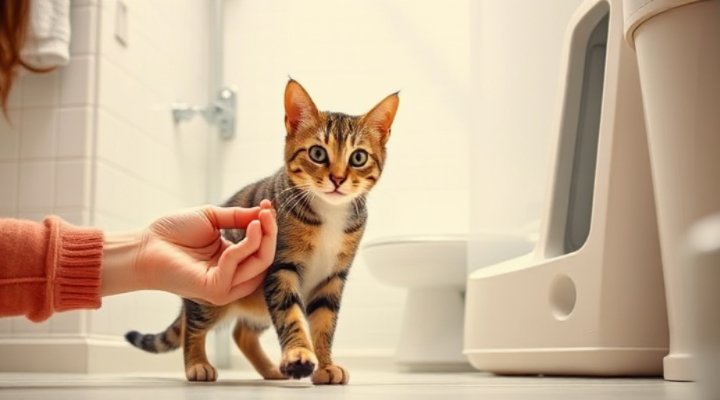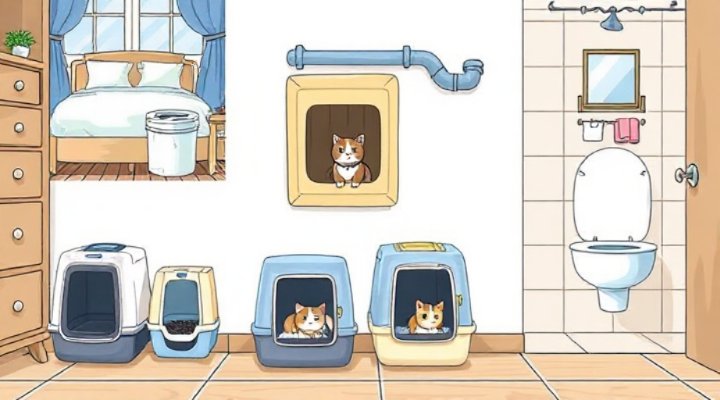Training a cat to use a litter box is one of those essential skills that can make pet ownership a joy rather than a chore. In other words, it’s all about setting up good habits from the start. For instance, I remember when I first brought home my kitten, Whiskers; he was curious but clueless about the litter box. With patience and these steps, he quickly learned, and now he’s a pro! So, if you’re wondering how to train a cat to use litter box, you’re in the right place. This guide will walk you through everything, from basics to advanced tips, ensuring a clean and happy home for you and your feline friend.

Understanding Why Cats Use Litter Boxes Naturally
Cats have an innate instinct to bury their waste, which stems from their wild ancestors avoiding predators. That is to say, most cats don’t need extensive training; they just need the right setup. However, on the other hand, some factors like stress or health issues can interfere. For example, if a cat avoids the litter box, it might signal a problem like a urinary infection. Therefore, observing your cat’s behavior is crucial. Moreover, providing a comfortable environment can make litter box training much smoother. In the same vein, learning about best cat food for indoor cats can support overall health, reducing stress during training.
Choosing the Right Litter Box and Litter
Firstly, select a litter box that suits your cat’s size and preferences. A large, open box is often best for starters, as it’s easy to access. Further, consider the type of litter; clumping litter is popular because it’s easy to clean. But, however, some cats prefer non-clumping or natural options like paper-based litter. For instance, my cat Whiskers took to silica gel litter because it felt soft on his paws. Above all, avoid scented litters initially, as strong smells might deter your cat. Similarly, placing the box in a quiet, low-traffic area helps your cat feel secure. During this phase, you might also explore wet cat food health benefits to keep your cat hydrated and comfortable.

Step-by-Step Guide to Train Your Cat
Now, let’s dive into the practical steps for how to train a cat to use litter box. Firstly, introduce your cat to the box by placing them in it after meals or naps. Use a gentle voice and positive reinforcement, like treats or praise. Subsequently, if they use it, reward them immediately to build a positive association. Meanwhile, keep the box clean; scoop waste daily and change litter regularly. For example, I made it a habit to clean Whiskers’ box every morning, and he started using it consistently. In addition, if accidents happen, don’t punish your cat—simply clean the area thoroughly to remove odors. Likewise, consistency is key; stick to a routine to reinforce the behavior.
Common Troubleshooting Tips for Litter Box Issues
Sometimes, cats resist using the litter box due to various reasons. To clarify, common issues include box location, type of litter, or medical problems. For instance, if your cat avoids the box, try moving it to a quieter spot or switching litters. But on the other hand, if the problem persists, consult a vet to rule out health issues. Consequently, addressing these early can prevent long-term habits. Moreover, using enzymatic cleaners for accidents helps eliminate smells that might attract repeat offenses. In the same vein, reading about Royal Canin urinary care for cats can provide insights into health-related litter box avoidance.

Maintaining Hygiene and Long-Term Success
Hygiene is paramount in litter box training. Firstly, clean the box at least once a day to prevent odors and bacteria buildup. Further, wash the box with mild soap weekly, avoiding harsh chemicals. For example, I use a vinegar solution for deep cleaning, which is safe and effective. Most importantly, monitor your cat’s habits; changes could indicate health issues. Similarly, providing multiple boxes in multi-cat households reduces competition and stress. During this process, consider integrating temptations cat treats for training to reward good behavior, enhancing the training experience.
Advanced Tips for Stubborn Cats
If your cat is particularly resistant, don’t lose hope. Firstly, try confining them to a small area with the litter box for a few days. This encourages use through proximity. Subsequently, use pheromone sprays or diffusers to reduce anxiety. For instance, Feliway products can create a calming environment. In addition, observe if there are triggers like loud noises or other pets. Likewise, consulting resources from authoritative sites like the American Veterinary Medical Association can offer professional advice. After that, be patient; some cats take longer to adapt, but consistency pays off.

Incorporating Positive Reinforcement Techniques
Positive reinforcement is a powerful tool in cat training. That is to say, reward your cat immediately after they use the litter box with treats, pets, or playtime. For example, I kept a jar of small treats near Whiskers’ box, and he soon associated it with positive outcomes. Moreover, avoid negative reactions to accidents, as this can cause fear. In the same vein, using clicker training can reinforce desired behaviors effectively. Further, make training sessions short and fun to keep your cat engaged. Consequently, this approach not only teaches how to train a cat to use litter box but also strengthens your bond.
When to Seek Professional Help
In some cases, professional intervention may be needed. Firstly, if your cat consistently avoids the litter box despite your efforts, it could signal underlying issues. For instance, behavioral problems or medical conditions like diabetes might be at play. Therefore, consult a veterinarian or a certified animal behaviorist. Similarly, resources from edu sites like Cornell University College of Veterinary Medicine provide reliable information on feline health. After that, they can offer tailored advice, ensuring your cat’s well-being and training success.

In conclusion, learning how to train a cat to use litter box is a rewarding journey that fosters a clean and happy home. By following these steps, using positive reinforcement, and maintaining hygiene, you’ll set your cat up for success. Remember, every cat is unique, so adapt these tips to fit your situation. For more insights, check out our other guides on healthy cat treats recipes and homemade cat treats for training. Happy training!
Related Keywords: cat litter training, litter box training for cats, how to train a kitten to use litter box, cat hygiene, litter box troubleshooting, cat behavior training, pet training tips, feline litter habits.
